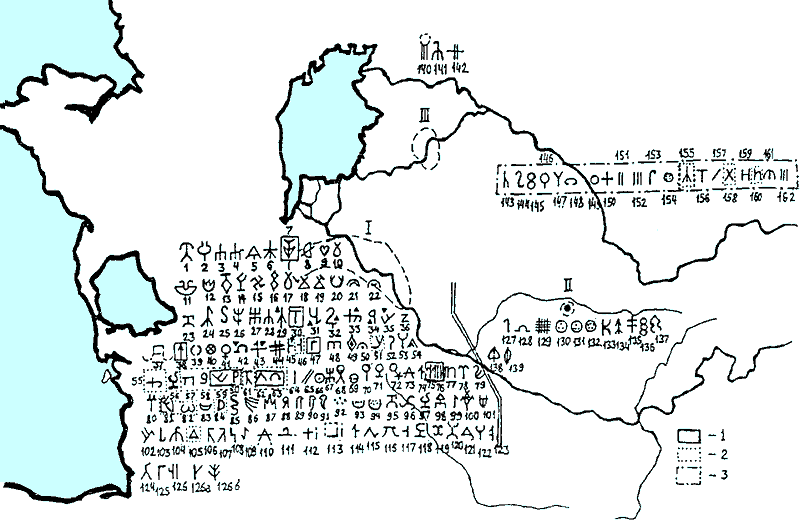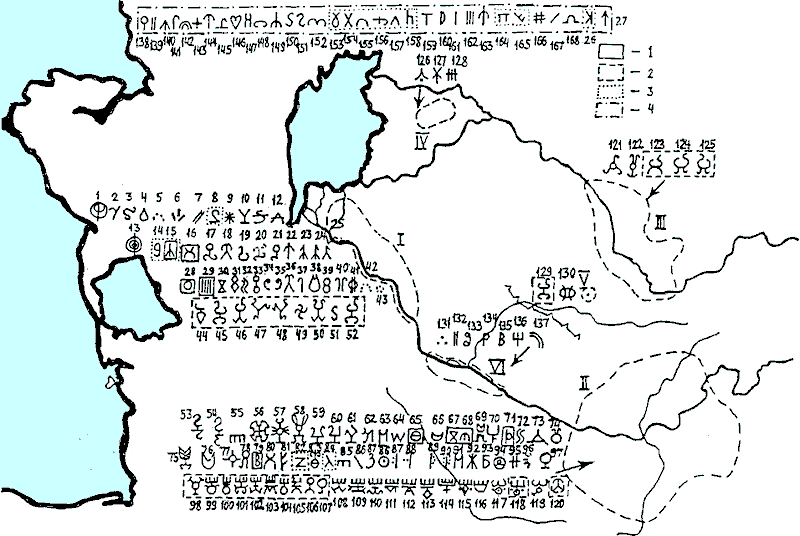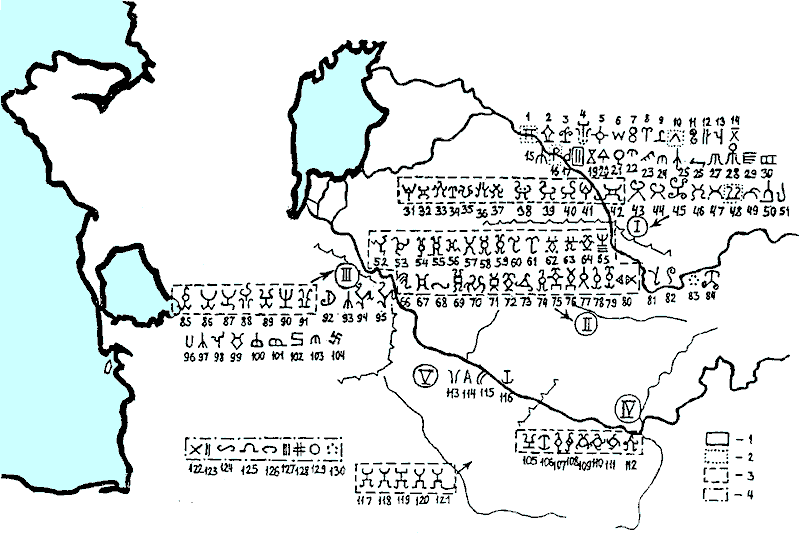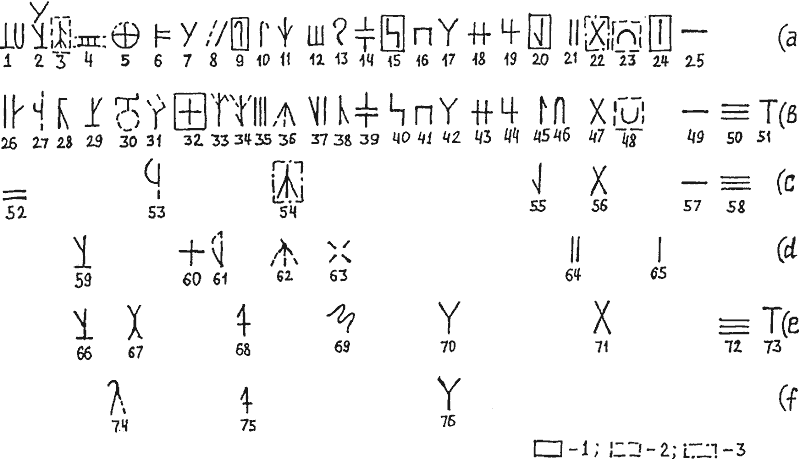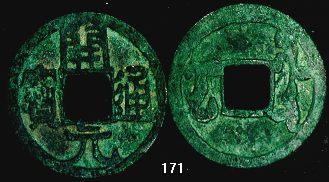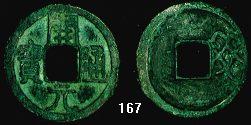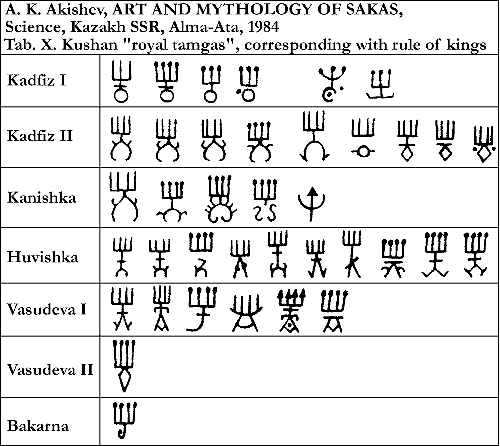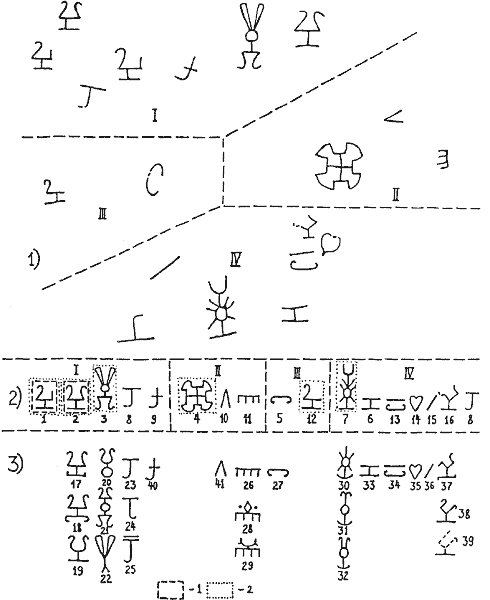|
Home Back In Russian Tamgas Contents Codex of Inscriptions Index |
Sources Roots Alphabet Writing Language Religion |
Genetics Geography Archeology Coins Wikipedia |
Ogur and Oguz Alans and Ases Overview of Sarmatian chronology |
Saltovo-Mayak Culture Codex of Inscriptions-Euro Asiatic-Don Alanian Etymology Notes Alans in Pyrenees |
Alan Dateline Avar Dateline Besenyo Dateline Bulgar Dateline Huns Dateline Karluk Dateline |
Khazar Dateline Kimak Dateline Kipchak Dateline Kyrgyz Dateline Sabir Dateline Seyanto Dateline |
||||||||||||||||||||||||||||||||||||||||||||||||||||||||||||||||||||||||||||||||||||||||||||||||||||||||||||||||||||||||||||||||||||||||||||||||||||||||||||||||||||||||||||||||||||||||||||||||||||||||||||||||||||||||||||||||||||||||||||||||||||||||||
 |
S.A.YATSENKO TAMGAS OF IRANOLINGUAL ANTIQUE AND EARLY MIDDLE AGES PEOPLES Russian Academy of Science Moscow Press ”Eastern Literature” 2001 ISBN 5-02-018212-5 Chapter 7 |
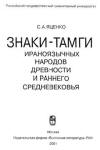 |
||||||||||||||||||||||||||||||||||||||||||||||||||||||||||||||||||||||||||||||||||||||||||||||||||||||||||||||||||||||||||||||||||||||||||||||||||||||||||||||||||||||||||||||||||||||||||||||||||||||||||||||||||||||||||||||||||||||||||||||||||||||||||||||
| <= Previous Section 6 - Alans | Table Of Contents | Next Section 8 - Persians => | ||||||||||||||||||||||||||||||||||||||||||||||||||||||||||||||||||||||||||||||||||||||||||||||||||||||||||||||||||||||||||||||||||||||||||||||||||||||||||||||||||||||||||||||||||||||||||||||||||||||||||||||||||||||||||||||||||||||||||||||||||||||||||||||
Selected Quotation | ||||||||||||||||||||||||||||||||||||||||||||||||||||||||||||||||||||||||||||||||||||||||||||||||||||||||||||||||||||||||||||||||||||||||||||||||||||||||||||||||||||||||||||||||||||||||||||||||||||||||||||||||||||||||||||||||||||||||||||||||||||||||||||||||
|
| ||||||||||||||||||||||||||||||||||||||||||||||||||||||||||||||||||||||||||||||||||||||||||||||||||||||||||||||||||||||||||||||||||||||||||||||||||||||||||||||||||||||||||||||||||||||||||||||||||||||||||||||||||||||||||||||||||||||||||||||||||||||||||||||||
Foreword to the citation of S.A.YATSENKO work | ||||||||||||||||||||||||||||||||||||||||||||||||||||||||||||||||||||||||||||||||||||||||||||||||||||||||||||||||||||||||||||||||||||||||||||||||||||||||||||||||||||||||||||||||||||||||||||||||||||||||||||||||||||||||||||||||||||||||||||||||||||||||||||||||
|
If you see that the text and illustrations
conflict at times, please do not despair, it could be a typo in the
S.A.Yacenko publication, or a misunderstanding on the Translator's part. The
tamgas are there, but the illustrations or callouts may be incorrect. A
closer look at the maps from which the numbers for the images are cited
would help to verify the connections and unconfuse the story. For hydrological and demographical situation in the Aral area see Tsvetsinskaya ”Amudarya Sarykamysh People". For demographical and ethnic situation in the Aral area see L.T. Yablonsky "Ancient Chorasmia". For the Tochar anabasis, see C.Benjamin "Migration of Yueji through Sogdia". The people who left the Aral tamgas were a blend of the Timber Grave heavy-set people of the type later called Paleosibirians, and the same anthropologically ”robust” people with a tint of Mongoloidness that populated Kazakhstan belt extending to Mongolia. These very same people, with nomadic or settled economy, left the tamgas enthusiastically called by S.A.Yatsenko ”Iranian”, when in fact they had not much common with the gracile morphology of the Indo-Iranians. So, if you see that the text calls Sarmatians ”Iranians”, or their word an ”Iranian word”, do not despair. If this study had ”Türkic-lingual” in its title, it would probably never see the light of the day, and we would have never learnt that the Kangars, Sogdys, Horasmians/Horezmians, Sarmats and Alans had common clans and common clan tamgas, that the royal families of the Horesmians and Sarmatians belonged to the same clans, that the dynasties of the Bospor, Olbia, Bactria were intimately connected all the way up to the Tashkent/Chach by their royal bloodlines, and would learn none of the enigmatic details of these fascinating popular and royal carousels. While the term ”Iranian” pervades the pages of the work as a scent of a dead cat in a high-rise, in these type of publications all the justifications for that are typically contained in a footnote 10 on page 13, or even may be hidden deeper in a comment to a footnote 13 on page 10. The radioactive potassium in the modern blood testing allows observing the bloodstreams and locate diversions, splits and clogs, and the tamgas allow us to see the origins, developments, relocations, activities and final resting places of the people who left for us these remarkable timestamps of their lives. The tracing inherently has an exceeding resolution for insights with increasing magnification, from a tribe level down to the clans, subclans, and in places literally down to individual extended families and historical personalities. One day we will find a mummified horse hide marked by a specific tamga with a little tail on it, and we will be able to visualize the extent of the possessions of that clan, extent of its travels, its burial grounds, and its herds. As with the signage traditions of our days, the deviations from traditional orientation of the tamga are irrelevant, like is irrelevant the orientation of a 5-point star on the US emblems, or a 6-point star of the Mogen Dovid, their significance is relayed exclusively by their form and not by the conditions of the object where they are placed. On the other hand, the relative orientation of modifier marks is significant, allowing, for example, to segregate the animals of a ”right hand” family from the ”left hand” family and other kins of the clan, and therefore the mirror images carry discerning connotations. At the same time, an ”assignment” of the tamga would be quite an aberration, like renaming ”McDougall” clan into ”Stuarts”, because every member of the society has his parents, and is destined to carry their tamga to his progeny. This aspect is especially pronounced in the societies where upbringing of the youngsters is traditionally a treasured right of their grandparents. The English rendition of the extensive citation of the work in is much simplified, with many details omitted and much reduced references, but with an eye to preserving the logic, facts, and evidence. The citation brings forward the author's comparisons, to allow for easy visual collation of the evidence. A reader should be aware that absolutely none of the dating was performed even with rudimentary scientific instrumentation, and with the exception of the dated coinage, all other dates are within the accuracy of educated opinions, which at times significantly differ, and time to time abruptly change. Any posting's comments notwithstanding, this work is a first major overview of the accumulated research, and we all should be limitlessly grateful for the titanic work performed by the author in researching, assembling and mapping the data, and for many of his insights that lay the ground for the future researchers. The author also notably deviates from the cleansed lexicon that came to use in the Russian academical works of the Soviet period by using Türkic terminology, integral to the Russian language, for the authentic Türkic phenomena, including the very term ”tamga”. | ||||||||||||||||||||||||||||||||||||||||||||||||||||||||||||||||||||||||||||||||||||||||||||||||||||||||||||||||||||||||||||||||||||||||||||||||||||||||||||||||||||||||||||||||||||||||||||||||||||||||||||||||||||||||||||||||||||||||||||||||||||||||||||||||
|
Chapter 7 | ||||||||||||||||||||||||||||||||||||||||||||||||||||||||||||||||||||||||||||||||||||||||||||||||||||||||||||||||||||||||||||||||||||||||||||||||||||||||||||||||||||||||||||||||||||||||||||||||||||||||||||||||||||||||||||||||||||||||||||||||||||||||||||||||
|
The tamgas of the Western Turkestan (Central Asia and Southern Kazakhstan) are known in Horesm, Sogd and in the lower course of Seyhun/Syr-Darya by the 6th century BC. It is possible to discern three primary periods of their active usage in the region before the massive migrations of the (Eastern? - Translator's Note) Türks and the Arabian conquests. The 1-st period covers the time from the beginning of active use of tamgas (6th century BC) to approximately before the massive migration of nomadic tribes from the east in the mid if the 2nd century BC (fig. 27).
Fig. 27. Tamgas of the Cheyhun/Amu-Darya and Seyhun/Syr-Darya basins (6th -
2th cc. BC)
The 2-nd period is connected with the nomadic dynasties (1st century BC) in Bactria, Horesm and Kangar (Ch. Kangüy) and comes to an end by the 4th century AD with a sharp weakening of Kangar, disintegration of Horesm and White Hunnia (Kushania), active intervention by the Persian Sasanids, and arrival of new influential nomads (fig. 28). Fig. 28. Tamgas of the Cheyhun/Amu-Darya and Seyhun/Syr-Darya
Basins (1st cc. BC - 3rd cc. AD)
The 3-rd period continues (from the beginning of the Persian dominance in the 5th c. AD) the before capture of significant territories of the Western Turkestan by Arabs in the 8th century (fig. 29). Fig. 29. Tamgas of the Cheyhun/Amu-Darya and Seyhun/Syr-Darya
basins (4th-8th cc. AD)
Tamgas were frequently impressed on saman bricks of public buildings and
walls of the. The representatives of the population (from the local and distant
clans) were summoned in for manufacturing bricks for the state fortresses as as
a labor obligation (see Section 1). It is no wonder, that the abundance of types
of tamgas on bricks is documented first of all during the existence of the
strong centralized state in this or that region (in the Horesm in the 4th
century BC- 3rd century AD; in Bactria during the Kushan
(i.e. Ku-Sün - Translator's Note) period of the mid 1st - beg. of the
4th century AD) (fig. 27-28). The abundance of tamgas on the ceramics (almost always potter's ceramics) is also typical mainly for the two regions most closely tied to nomads, Horesm and Kangar (Ch.Kangüy) (Middle Seyhun/Syr-Darya). Found in a fortresses in Horesm tamgas on ceramics does not mean that the ceramics are made there. For Horesm are typical special settlements of ceramists far from other settlements, supplying the whole district under a state control. Per S.B.Bolelov, in one small settlement, as a rule, are found zones of trading activity of the several specialized ceramists settlements. The tamgas usually were marked during manufacture on the shoulders of the large vessels (pots, jugs, hums), less often on a near-bottom portion and on a bottom. They are also known on the small size vessels (bowls). (About the purpose of these ”manufacturing brands” see Section 1.10.) Occasionally, tamgas were marked on the drain pipes (koburs), Horesmian ossuaries and terracottas of Bactria and Horesm of the Kushan period (1st-3rd centuries), and sometimes earlier (Koi-Krylgan-kala). A special attention of researchers attracted tamgas on the bricks of the fortification walls (occasionally also palace buildings) on such fortresses of Horesm as Djanbas-kala (4th-3rd centuries BC), Elharas and Kaparas (4th century BC), Kurgashin-kala (4th-2nd centuries BC), such monuments of the Kushan period as Toprak-kala (2nd century AD), Kzyl-kala (1st-2nd centuries AD), Gyaur-kala Sultanuizdag, Tok-kala. Judging by the quantity of tamgas, in the construction of small fortresses took part representatives of 8-10 to 15 clans. In the Bactria, the most representative collections of tamgas were encountered in the fortresses in Baktrah II (Balkh), Kei-Kobad-shah, the Dalverzintepe, Dilberdjin. In the Sogd, they are plentifully represented in the early layers of Samarkand, are known on the ceramics of late settlements of the 3rd-8th centuries. From the beginning of the 2nd-1st centuries, or from the 1st century BC in the Kangar (Ch.Kangüy), Horesm, Bactria and Sogd emerge the coins with tamgas, brought from the east by the new nomadic conquerors: Üechjes, Usüns and Sakas (fig. 28-29). The analysis of not too numerous ”encyclopedias” of the Central Asia is very important. So, in the possessions of Kangar (Ch. Kangüy) the quantities of tamgas on the cliff Kalmak-Krylgan, in the Kushan period Bactria is known a collection on the columns of a temple in Tahti-Sangin, in Sogd is known a collection on the potter's ceramics, and in the Horesm is known a collection on the cliff in the Kara-tuba highland. 7.1. Horesm The most ancient tamgas on the bricks in Horesm appear from the moment of
their use in the construction of the state objects in the 6th century BC. Since
7th-6th centuries BC appear the most ancient series of tamgas on the ceramics in
Khumbuz-tepe, potters' settlement existed there since the turn of the 7th-6th
centuries until the3rd century BC. In this uninhabited center of ceramic manufacturing the production was probably started by the masters from the neighboring Margiana with their own technology. Probably, these first masters (or more likely to their pupils in the 6th century BC) belong the first tamgas of three types (fig. 27/111-113). These large tamgas (length up to 5-7 sm) were a brand of the master on a clay disk of his potter's wheel. Later, from the 4th century BC, when finally forms a standardized artisan manufacturing under a state control, the tamgas began to be marked already as a graffiti on the vessel walls (however, exceptions are also known).
The bricks with tamgas from the Horesmian public structures of the 6th century BC- 2nd century AD (see the summary of types on fig. 27-28) were investigated by A.N.Gertman. He established for different locations the so-called ”main” tamgas of the brick makers (see Section 1). From his data, the most interesting for us are, first of all, the simple types (fig. 27/63, 92, 149), which were used at least for a few centuries (from the 4th century BC to the 2nd century AD), and frequently constitute more than 10-20 % quantity on various objects.
Generally, exist a certain continuity of the tamga forms before and after the crucial for the Horesm 2nd century BC. It is proposed that certain most widely spread tamga could be ”a production sign” for a group of people working on the ”capital city” objects in charge of the ”palace department”. Generally it is possible, because for example, for the construction of the High Palace in the Toprak-kale it was needed approximately 6 million bricks prepared beforehand on the side. In the Djanbas-kale was found that two different sections of the walls were built by two different groups of clans with dissimilar tamgas Tamgas - graffiti on the potter's ceramics are especially richly represented on a series of monuments of the 6th-2nd centuries BC (fig. 27) in Koi-Krylgan-kale, Kalaly-Gyr, Djigerbent. The tamgas, probably, are not personal tamgas of the masters, but ”industrial tamga”, a symbol of a workshop (see Section 1.10). The brands on the bottom were also found in the burial of the 4th-5th centuries AD Tarym-kaya,
left by the new newcomers - cattlemen. A big interest presents the remarkable unpublished collection of tamgas on the Koi-Krylgan-kala ceramics (fig. 30). Fig. 30. Unpublished tamgas on the pottery from Koy-Krylgan-kala (Horesm)
Usually, tamgas were casually scored with a sharp object before firing. Sometimes a unary tamga in Koi-Krylgan-kale appeared on images of a person (on terracottas; a ”royal” tamga (fig. 28/51) (fig. 28/48? - Translator's Note) on the trunk of a horse: the image of a mounted horseman-soldier on a flask from Koi-Krylgan-kala). It is necessary to especially note a series of tamgas on late clay ossuaries of the 7th-8th centuries from Mizdahkan, where among the others are two tamgas (fig. 29/94-95) (+fig. 29/102? - Translator's Note), typologically related to one of the ”royal” tamgas (fig. 28/47).
The tamgas on the Horesmian coins of mid 1st-8th century AD (fig. 28/44-52; 29/85-91) were comparatively well investigated. Minting began almost simultaneously with the introduction of their own Horesmian era, established by the new, nomadic by its origin, dynasty. With a significant variation of the royal tamgas, significant is the presence of the 7 ”closely related types” of the legendary Siyavushid dynasty (fig. 28/45-46, 50, 52; 29/86, 88-89), and the so-called ”basic tamga” that has arisen, by B.I.Vainberg's definition, soon after the beginning of the stamping. Above, was addressed the relationship of a part of these tamgas with the tamgas of the nobility of other Irano-lingual ethnoses (calling Türkic legends on the coins ”Irano-lingual” still remains a hallmark of the Russian scientology. These legends, which remained enigmatic due to the myopia by design of the discredited Soviet research system, were comfortably read by Azgar Mukhamadiev, see citation here. The version of the dating used by the author is also two centuries off, as was suggested years before the publication of his work. In respect to the ancient Turanian dynasty of Siyavushids, click here. In the Avesta, that perpetual bible of the Indo-Iranists, the Turanians are depicted as eternal aliens and foes of the heroes of the Avestan scripture, the heroes are presumed these days to be not just co-religionists, but homogenous indigenous Indo-Iranians. This work of S.A.Yacenko greatly expands the known reach of the Siyavushid dynasty in space if not in time, providing evidence of its leading role extending to the nomadic nations fleeing from the Gansu province located beyond the 110° eastern longitude. A cursory look at the ”Siyavushid” tamgas indicates participation of multiple clans under the label of Siyavushids, not unlike the passage of the rule (and hence of the ruler's tamga) in the Danube Bulgaria, known from the Sherdjere (Nominalia) list. For extra flavor I am adding below the Horesmian-type tamga of Atilla's son Diggiz - Translator's Note)
Today are also known collections of the tamga ”encyclopedias”. A most interesting of them is presented in the district Kara-tuba on the solitary among an extensive plain ”cliffed” ravine of the Cheyhun/Amu-Darya. For the dating of its petroglyphs is important a presence there of the specific early Horesmian tamgas of the 1st period. One of them is presented only on early ceramics (4th century BC) in Kaparas; another one on the synchronous bricks from the same place (fig. 27/7, 32). Probably, here the people of different epochs ”left theit signatures”, and to separate accurately the late-antique images, for example, from the early Middle Ages is almost impossible for now.
Anther collection is presented on a small Horesmian silver bottle, found in a kurgan near Shadrinsk in the Southern Urals (fig. 34, å). Here are accurately engrooved a royal tamga (fig. 28/52) and the Horesmian tamgas of two more types (fig. 28/16,155), dated by the 2nd Horesmian period.
During the late period are also known the tamgas on the bronze seals of the owners of individual castles (castle no. 9 of the 7th-8th centuries in the Berkut-Kalin oasis).. 7.2. Sogd The most ancient tamgas of the Sogd are known on the fortifications bricks from the earliest layers of its capital, the fortress Afrasiab (ancient Marakanda/Samarkand) (fig. 27/127-139, 144-149, 151, 158). They are dated by the 6th century BC (Pre-Ahaemenid time). These early tamgas are drawn very casually; most frequent are types 127,145-146,161.
(The tamga fig. 158 is known to survive from ca. 600 BC until the time of Kipchak Khanate in the 1200th AD as a Kipchak state tamga ”two knives” - Translator's Note) A big interest presents the unique tamga on the left hip of a horse of
the main hero of an epic scene from kurgan 2 of the burial Orlat (Kurgan-tepe)
near Samarkand (fig. 28/130
The tamgas on the coins of the Chinese type of the politically fragmented early Middle Ages Sogd are very diverse (fig. 29/52-80). They are on the reverse on the right or left, in pairs on both sides of a square hole (the hole is framed by a flat lapel that too frequently was designed as a component of the tamga). Occasionally a pair of co-ruler (?) tamgas was stamped next to each other (fig. 14, p; the left tamga is letter ”ho” of the Kharoshthi alphabet). Especially permanent in the monetary minting of the Samarkand Ihshids the tamgas of the type presented on fig. 29/74 (only Varhuman in mid of the 7th c. used its mirror image: fig. 29/54). A ”small”, additional tamga in the Sogdian dynasties could not only change individually, but also be repeated (tamgas on fig. 29/73 of three rulers). On the coins of individual possessions (Pendjikent) each subsequent ruler could add to the clan tamgas one or two additional symmetric lines (fig. 29/64, 72, 76).
5 Was even expressed an opinion that all these monetary types ascend to the coins of the
Ihemenid dating became quite obvious to the majority of researchers only in the mid of the 1980's. The published materials on the graffiti-tamga on ceramics are extremely scarce. They are known on the vessels from Djanal-tepe in the Southern Sogd (in the initial publications dated not later than the 6th century). Here, the two of three tamgas (comparatively well preserved) represent... the tamga of the later rulers, Turgar and, probably, Varhuman (fig. 29/79, 54).
7.3. Bactriana/Tokharistan In Bactria the start of the distribution of tamgas coincides with the conquest of that area by the nomads, Great Yuechjis (Tochars) in the 2-nd half of the 2nd century BC. Mostly the tamgas known today were impressed on the bricks of the Yuechjian-Kushanian fortresses of the 2nd period (fig. 28). Fig. 28. Tamgas of the Cheyhun/Amu-Darya and Seyhun/Syr-Darya
Basins (1st cc. BC - 3rd cc. AD)
The quantity of tamgas on each monument depended, certainly, (in addition to the degree of its investigation) on the scope of construction. So, in Kei-Kobad-shah were only three types of tamgas, in a large Dalverzin-tepe were 12 types, in Dilberdjin were 19. Sometimes even large buildings contained bricks with tamgas with a quantity of types (the house 3 in Hanaka-tepe had 23 types!), probably from disassembled walls of old fortifications. On the Kushan coins (fig. 28/98-107,120) the first king Kudjula Kadfiz (per N.Sims-Williams and D.Kribb's chronology 30-80 AD) (fig. 28/98) the tamga is still very close to the tamga of the ruling before him Indo-Scythian king Gondofar. But from the third ruler, Vima II Kadfiz (90/110-100/130 (fig. 28/99) all Kushans in the top part of their tamga posted a clan tamga of four, and sometimes of three-prong ”fork”, and the lower portion had an individuall depiction. Some kings depicted on their coins close or dissimilar tamgas (Kudjula Kadfiz: fig. 28/98, 120; Vasudeva G. fig. 28/104 and a four-prong variation), and the late rulers, Vasishka (222/242-240/260) and Kanishka III (241/261-270/290), had an identical tamga: fig. 29/103. The Kushano-Sassanid coins of the Kushan design (of the 3rd-4th centuries) also frequently imitate the mint of one of the last strong rulers of the Kushania, Vasudeva I (164/184-200/220). Along with the old tamgas (including tamgas with altered connotation of the Shivaist nandipada symbol, fig. 28/117, and altered tamga of Vasudeva fig. 28/118) on the coins appear the tamgas of the Sassanid viceroys, the Kushanshahs. In the early Middle Ages in the Tokharistan on the coins predominates a single tamga of a particular clan.
Sometimes (like the subsequent Persian Sassanids), the Kushan aristocrats
wore a hat, on a side of which was a large tamga (fig. 105) (sculpture of
a ”prince” in
the dynastic sanctuary in Mathur). Collection of tamgas is known on the base of a stone column in the sanctuary Tahti-Sangin (fig. 31). Fig. 31. Collection of tamgas on the column from Takhti-Sangin (Bactria)
A multitude of tamgas were depicted there, but they were chiseled by too thin lines, and the majority of them faded with time. 4 assemblies with 19 tamgas of 16 types can be read. In each assembly are from 2 to 7 tamgas, and there are unique samples; they never overlap each other and as a whole are usually lined up. This collection has tamgas with the greatest affinity with the earlier Horesm tamgas of the 1st period (fig. 27/9, 55, 111 and with the others, less for typical for Horesm).
The tamga collectionn in the rich estate of the Kushanian city Dalverzintepe is not any less interesting. They depicted on a plaster of northern sector of the walls of a bypass corridor (other tamgas are marked in other five sites). Tamga are of 6 types and different sizes, and one of the types is repeated three times (fig. 28/157) (see also: fig. 28/159, 52, 54, 69, 75-76). An attempt by Dj. Ya.Ilyasov, with a very complex logical chain, to prove that these tamga are made much later by the Ephtalite conquerrorsi, contains a number of unreasonable stretches and unfortunately cannot be accepted. 7.5. Kangar (Ch. Kangüy)/Chach/Tashkent During the Roman time, Kangar (Ch. Kangüy) played an important role in the region, controlling the northern section of the Great Silky Road. The local monetary mint begins in 2nd century BC with counter-stamping of the Greko-Bactrian coins of Eukratid (fig. 29/14). Later, from the 2nd-3rd centuries, similar tamga were stamped on the reversers of the coins of the local mint (fig. 29/38-40). Among the first ”rulers of Chach” is mentioned Navanshar (fig. 29/40), of the later rulers are Bnchkr, Rwchk, Tarnavkh and others (fig. 29/31). In the autonomous possessions on the pre-Arabian coins normally was stamped tamga of the ruling clan, among them Farankat (fig. 29/32), Kabarna (fig. 29/33), Kanka (fig. 29/35).
The tamgas on ceramics were mostly in the top part of the pots and
jugs, occasionally in their bottom part (fig. 29/20
The ”encyclopedia” collections in the ”indigenous” lands of the Kangar in the Middle Seyhun/Syr-Darya are not known yet. One of them was casually sketched by A.A.Spitsyn from the Kalmak-Kyrgan cliff somewhere in the vassal territories of the Kangar. Out of six readable tamgas there are exact analogies with the lower Don tamgas of the 2nd-3rd centuries (fig. 29/2, 4 - fig. 6/25, 26) and the closest with the Crimean tamga of the 1st-2nd centuries (fig. 29/1 - fig. 5/14).
99 7.6. Middle Cheyhun/Amu Darya In the Amul area in a number of settlements are known primarily the tamgas on the bricks of a small fortresses (not less than 5-7 clans worked on construction). The majority of the buildings belong to the 1st-4th centuries AD, a part is dated 5th-7th centuries. 7.7.Lower course of Seyhun/Syr-Darya. For the periods of the 1st and 2nd cc. we only have tamgas on ceramics. |
||||||||||||||||||||||||||||||||||||||||||||||||||||||||||||||||||||||||||||||||||||||||||||||||||||||||||||||||||||||||||||||||||||||||||||||||||||||||||||||||||||||||||||||||||||||||||||||||||||||||||||||||||||||||||||||||||||||||||||||||||||||||||||||||
| <= Previous Section 6 - Alans | Table Of Contents | Next Section 8 - Persians => | ||||||||||||||||||||||||||||||||||||||||||||||||||||||||||||||||||||||||||||||||||||||||||||||||||||||||||||||||||||||||||||||||||||||||||||||||||||||||||||||||||||||||||||||||||||||||||||||||||||||||||||||||||||||||||||||||||||||||||||||||||||||||||||||
| Section 11 - Tamgas Of Middle Ages Alans => | Section - Literature and Sources => | |||||||||||||||||||||||||||||||||||||||||||||||||||||||||||||||||||||||||||||||||||||||||||||||||||||||||||||||||||||||||||||||||||||||||||||||||||||||||||||||||||||||||||||||||||||||||||||||||||||||||||||||||||||||||||||||||||||||||||||||||||||||||||||||
